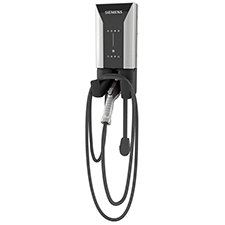
Today’s EV Chargers Powering Up Functionality
Chuck Ross
The electric vehicle (EV) market has had a great 2022, reaching approximately 6% of total U.S. auto and truck sales in the third quarter. While that might seem a small percentage, consider that it’s up from just 2.2% during the same quarter in 2020. Of course, all those new vehicles need charging, so the home charging market is growing almost as quickly. And as is often the case when it comes to new home appliance categories, charger technology is advancing rapidly to include new smart features that, in this case, could help the devices become critical players in residential energy management.
If you want to understand how EV adoption could grow so quickly, it could be helpful to consider where today’s LED lighting market is, versus where it was a decade ago. In those early days, LEDs were struggling to match the output of standard incandescent and compact fluorescent lamps and fixtures and prices could hit $60 for a single bulb. Flash forward to today, and LEDs rule big box lighting aisles, with advantages like highly efficient operation, decades’-long lifespan and advanced controllability previous technologies simply couldn’t offer. EVs and their chargers are improving just as quickly.
If you’re new to these products, the terminology can be a little confusing. For home installations, the options fall into two categories, Level 1 and Level 2. Level 1 charging cords are essentially extension cords that plug directly into a standard 110/120-volt outlet, supplying 3-5 miles of driving range per hour. Most buyers will want a higher-output Level 2 charger that can top off their batteries overnight. At the lower end of this market, offerings are still pretty basic, with no real added intelligence or connectivity. Go up just another couple hundred dollars, though, and you’ll find products with app-based, Wi-Fi connected controls that allow owners to manage and monitor charging operations – and get detailed reports on charging rates and total kilowatt-hours used – from their smartphones.
Such communications capabilities might not seem like need-to-have functionality, but they can help charging become more efficient and affordable, especially as upgrades bring in capabilities to participate in utility incentive programs to manage overall demand. And models are just starting to come to market with bidirectional capabilities that could make EV chargers – and the batteries they’re connected to – even more directly tied into home operations. Among the first of these is the Ford Charge Station Pro, developed by the automaker and Siemens for use with the new F-150 Lightning pick-up truck. This unit can draw on the truck’s battery to power a home for up to several days or more. GM is working on a similar approach for its upcoming Silverado EV pick-up. This advanced tech could give car buyers a new reason to consider an EV purchase, with their new vehicle becoming a backup-power option.
If you want to understand how EV adoption could grow so quickly, it could be helpful to consider where today’s LED lighting market is, versus where it was a decade ago. In those early days, LEDs were struggling to match the output of standard incandescent and compact fluorescent lamps and fixtures and prices could hit $60 for a single bulb. Flash forward to today, and LEDs rule big box lighting aisles, with advantages like highly efficient operation, decades’-long lifespan and advanced controllability previous technologies simply couldn’t offer. EVs and their chargers are improving just as quickly.
If you’re new to these products, the terminology can be a little confusing. For home installations, the options fall into two categories, Level 1 and Level 2. Level 1 charging cords are essentially extension cords that plug directly into a standard 110/120-volt outlet, supplying 3-5 miles of driving range per hour. Most buyers will want a higher-output Level 2 charger that can top off their batteries overnight. At the lower end of this market, offerings are still pretty basic, with no real added intelligence or connectivity. Go up just another couple hundred dollars, though, and you’ll find products with app-based, Wi-Fi connected controls that allow owners to manage and monitor charging operations – and get detailed reports on charging rates and total kilowatt-hours used – from their smartphones.
Such communications capabilities might not seem like need-to-have functionality, but they can help charging become more efficient and affordable, especially as upgrades bring in capabilities to participate in utility incentive programs to manage overall demand. And models are just starting to come to market with bidirectional capabilities that could make EV chargers – and the batteries they’re connected to – even more directly tied into home operations. Among the first of these is the Ford Charge Station Pro, developed by the automaker and Siemens for use with the new F-150 Lightning pick-up truck. This unit can draw on the truck’s battery to power a home for up to several days or more. GM is working on a similar approach for its upcoming Silverado EV pick-up. This advanced tech could give car buyers a new reason to consider an EV purchase, with their new vehicle becoming a backup-power option.
Photo courtesy of Siemens



